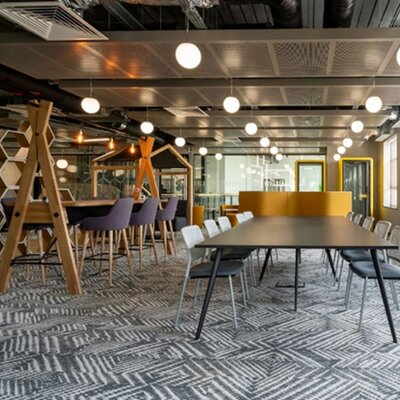
Ashdown Phillips appointed to manage five of AshbyCapital’s flagship London office and retail properties
October 17, 2023
We are delighted to announce 16 promotions across Ashdown Phillips
November 8, 2023Why WeCrashed shouldn’t deter landlords from investing in flexible workspaces.

Nikki Gibson, Director and Head of Flexible Workspaces
With WeWork currently in the process of renegotiating ‘almost all of its leases’ worldwide, the debate about the future of coworking still features prominently in the business news agenda.
As the poster-child of coworking brands, WeWork’s woes could leave property asset managers and landlords questioning whether this flexible, coworking model makes any commercial sense for landlords, especially as more businesses attempt to coax their staff back to the office.
The consensus seems to be that most of us want a hybrid option; very few people want to work fully remotely, very few want a return to the old office-based 9-5 day. Flexible working is here to stay and landlords are responding - with flexible workspaces now becoming a key part of the portfolio.
This shift is reflected in the ongoing shortening of leases. A recent study from Re-Leased showed a notable decrease in the average length of UK commercial leases over the last four years, now down to 34 months, a 34% drop from 2019.
WeWork’s challenges have been specific to their business model, as anyone who has been following the former unicorn’s downfall, or watched the incredible Apple TV drama WeCrashed, will know.
By using venture capital funds to secure long-term leases, often at a premium, the business was prioritising growth above financial sustainability. Of course, from a landlord’s perspective, many recognised that these deals were too good to be true, and we know many astutely inserted additional terms such as minimum break-clauses and bank guarantees to avoid being left high and dry should circumstances change.
The concern now, is for any landlords who are left exposed, and that other coworking providers, having to compete in an unbalanced marketplace, may also have overstretched themselves.
They too might be looking to renegotiate those leases, especially in locations where supply is high, occupancy is low, and churn is high.
This is why the flex market is proving so attractive.
In flex, rather than sub-let an entire space to one coworking brand, a property management company manages sub-letting on the landlords behalf - offering a similar flexible offer to occupants, but affording greater flexibility and visibility to the landlord. And it’s a growth category - Instant Group reporting in their 2023 UK State of the Flex Market that more than half of UK landlords plan to introduce additional flex space across their portfolio.
So how can landlords work with flex space providers, and can avoid the potential pitfalls?
Traditionally, landlords have negotiated a lease with providers such as WeWork, IWG or The Office Group - effectively delegating all responsibility and control over the space.
While previously this may have seemed like the safest bet in terms of ensuring a space was let, coworking providers make no allowance for changes in the market and rely on consistently high occupancy rates to ensure that they are running profitably.
With coworking providers, landlords also lack control over how the space is managed: with the providers operating entirely independently, they are obliged to provide only basic details and solely own the relationship with occupiers.
If the coworking provider is not performing or tarnishing the image of the property asset, the landlord is potentially stuck with them until the end of the lease… as long as they are able to pay their rent!
This is why the alternative to the traditional model - entering into a management agreement with a flex space operator, who will either work under their own brand or that of the landlord - is proving to be an attractive alternative.
Flex allows the landlord full control and visibility over the asset, as well as the benefit of having an on-site team building a close relationship with occupiers. A reliable and dedicated on-site team, there for the long-term, means landlords can ensure that the space is run to the standards desired, and get detailed feedback on performance.
With loyalty to a brand or building far from guaranteed, having dedicated customer service people on-site - who are invested in the building’s success - means those people are likely to stay longer in post and build stronger relationships with occupants.
The close relationship also allows for a conversation about taking on a traditional let, should the occupier outgrow flex space to take place naturally. In the past, one of the major hurdles for landlords with this model was about how to value a flexible workspace that is not under traditional lease. But given the strong position flex space now has in the market, valuers have become comfortable with this model and there is now clear guidance supplied for valuers.
Where WeWork once presented a genuine alternative to the “traditional” office, the market has moved on. ‘Free’ beer, nice sofas and ping pong tables are no longer enough of a pull - occupiers expect state-of-the-art design with a wide range of facilities, excellent connectivity, exceptional service, added-value initiatives such as health and wellbeing, networking and business events, as well as the highest sustainability credentials.
By choosing an owned flex model over a coworking provider, landlords can offer this flexibility directly - having an trusted partner on site at a building to provide a face-to-face service for the occupiers also allows for a constant supply of feedback as to how the space is working, allowing everyone to ensure that the space is constantly adapting to make sure it is fit for purpose for customers and that any potential issues can be headed off without becoming the subject of a hit streaming drama series.
Nikki Gibson, Director & Head of Flexible Workspaces




